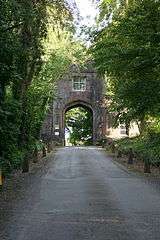Markree Observatory
Markree Observatory was an astronomical observatory in County Sligo, Ireland.
History

In 1830, Colonel Edward Joshua Cooper MP (1798–1863) eldest son of Edward Synge Cooper MP, and Ann, daughter of Henry Vansittart, Governor of Bengal, set up Markree Observatory on the grounds of Markree Castle near Collooney in County Sligo.
In 1831 Cooper acquired from Robert A. Cauchoix of Paris an objective of 13.5-inches (35.5 cm) for which he paid £1200. In 1834 he mounted the lens on an equatorial mounting supplied by Thomas Grubb of Dublin. For a number of years Cooper’s big refractor was the largest in the world. He used the telescope to sketch Halley's comet in 1835 and to view the solar eclipse of 15 May 1836.[1]
Later a 5-foot (1.5m) transit and a 3-foot (0.9m) Meridian Circle, fitted with an interchangeable 7-inch (17.75 cm) glass were added, which was the largest at that time in 1839. In 1842 a 4-inch (10 cm) Comet Seeker was added.
"The Observatory of Mr Cooper of Markree Castle - undoubtedly the most richly furnished private observatory known - is worked with great activity by Mr Cooper himself and by his very able assistant, Mr Andrew Graham." (Royal Astronomical Society, 1851)[2]
In 1848, Cooper’s assistant, Andrew Graham, discovered the asteroid 9 Metis with the Comet Seeker. Graham resigned his post at Markree in 1860, but continued his research at Cambridge Observatory until his retirement in 1905. E.J. Cooper died in 1863, but the observatory remained active until the death of Edward Henry Cooper MP in 1902.
See also
References
- ↑ History of the Cauchoix objective
- ↑ Monthly Notices of the Royal Astronomical Society, volume 11, page 104 - 105, 1851
Coordinates: 54°10′27″N 8°27′41″W / 54.174286°N 8.46147°W